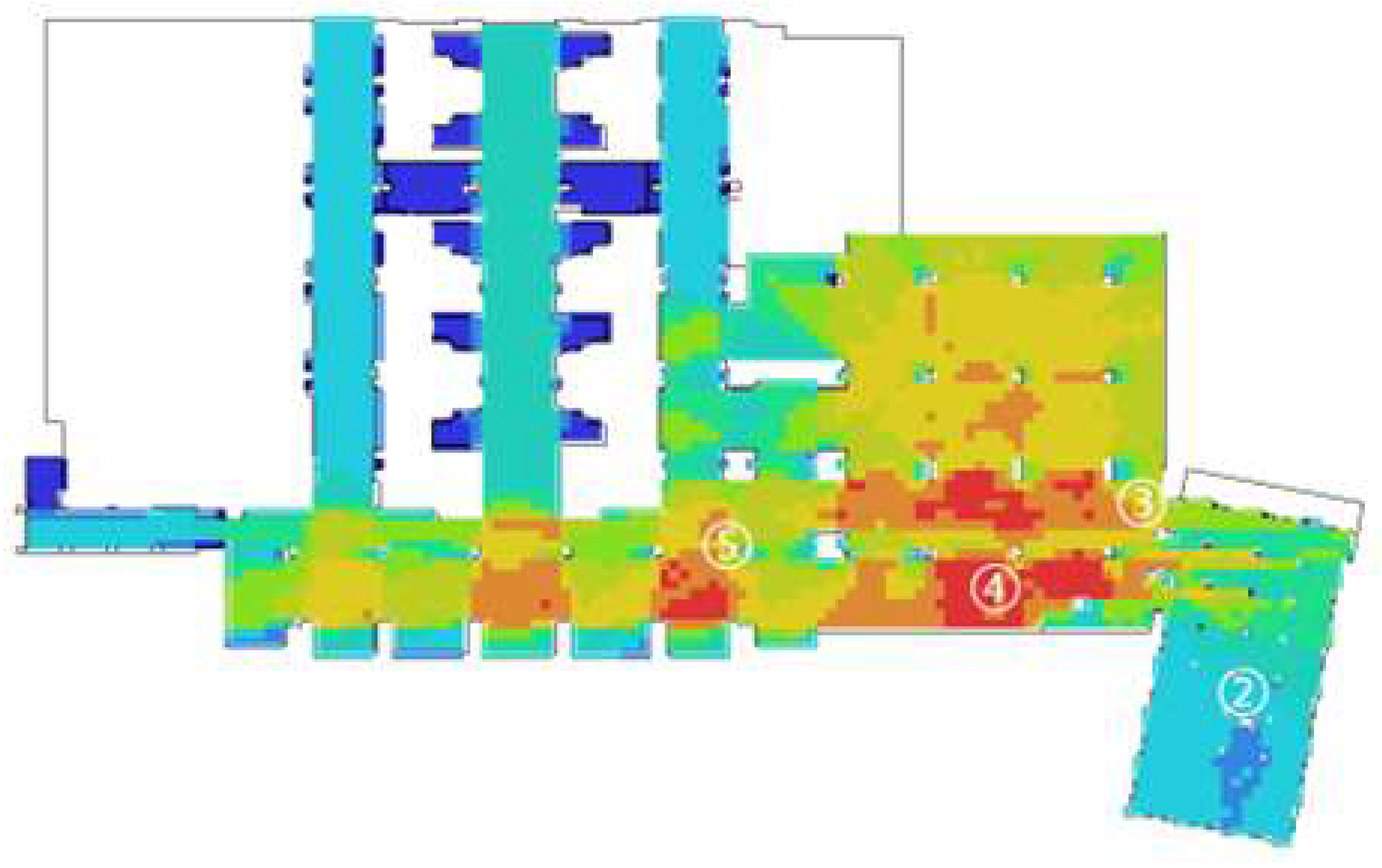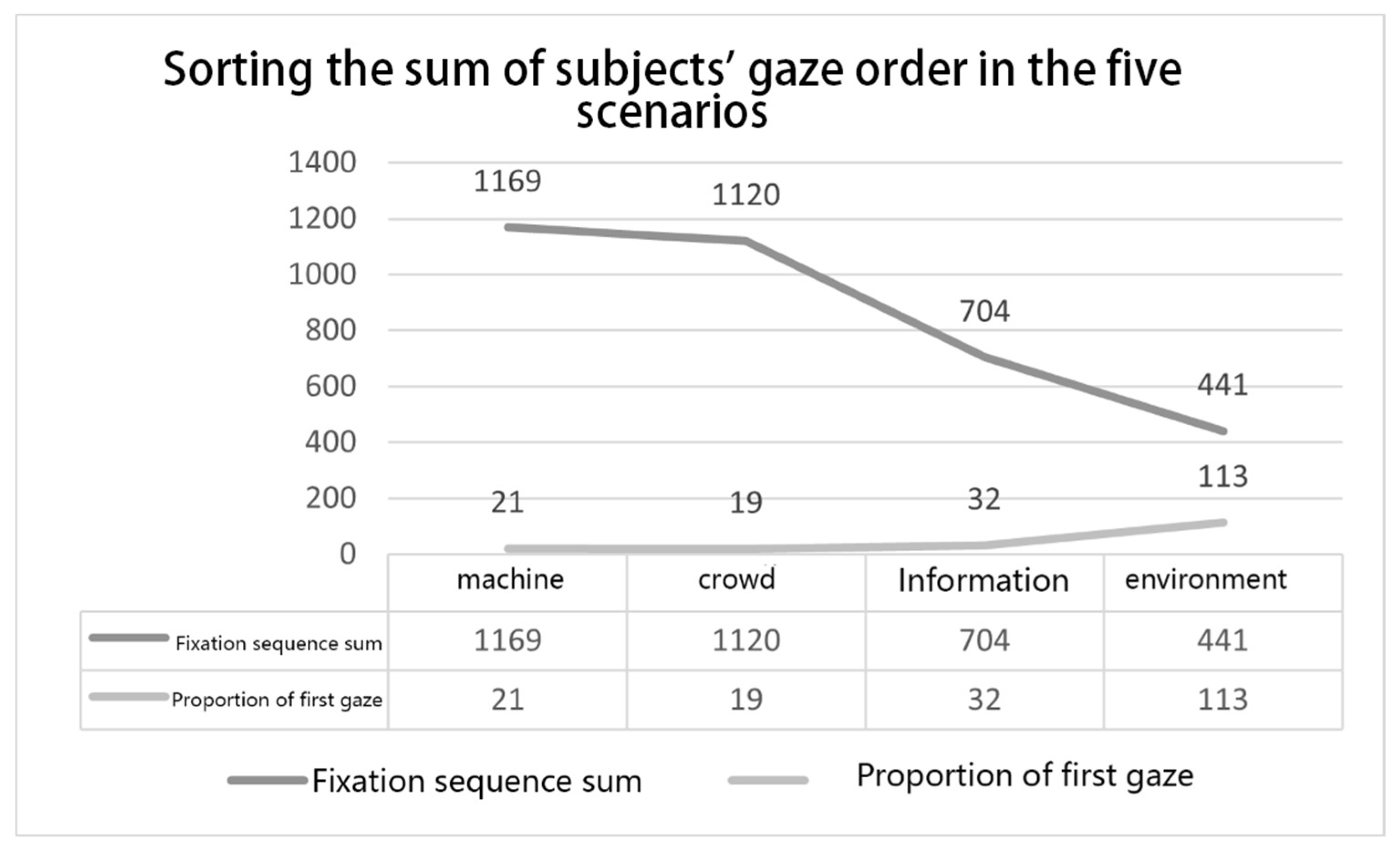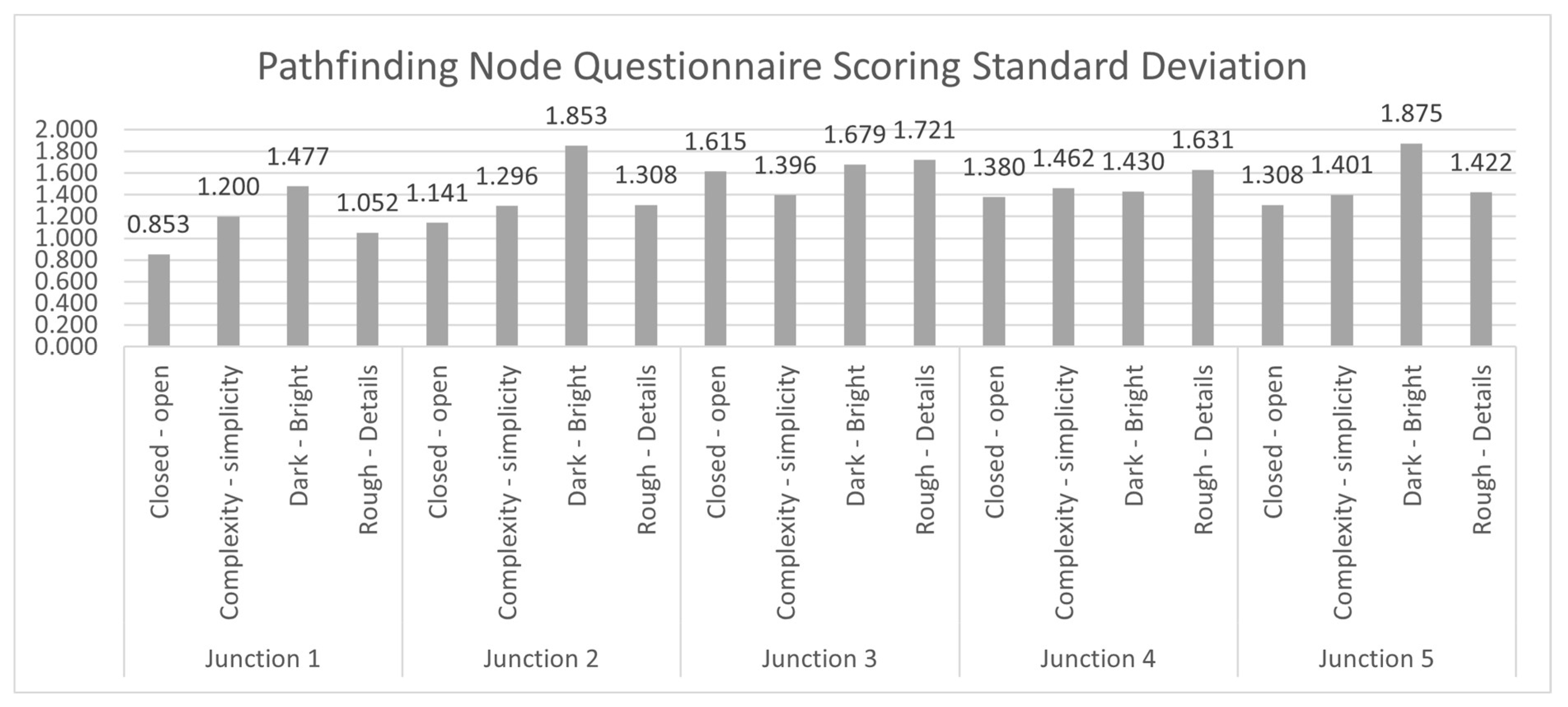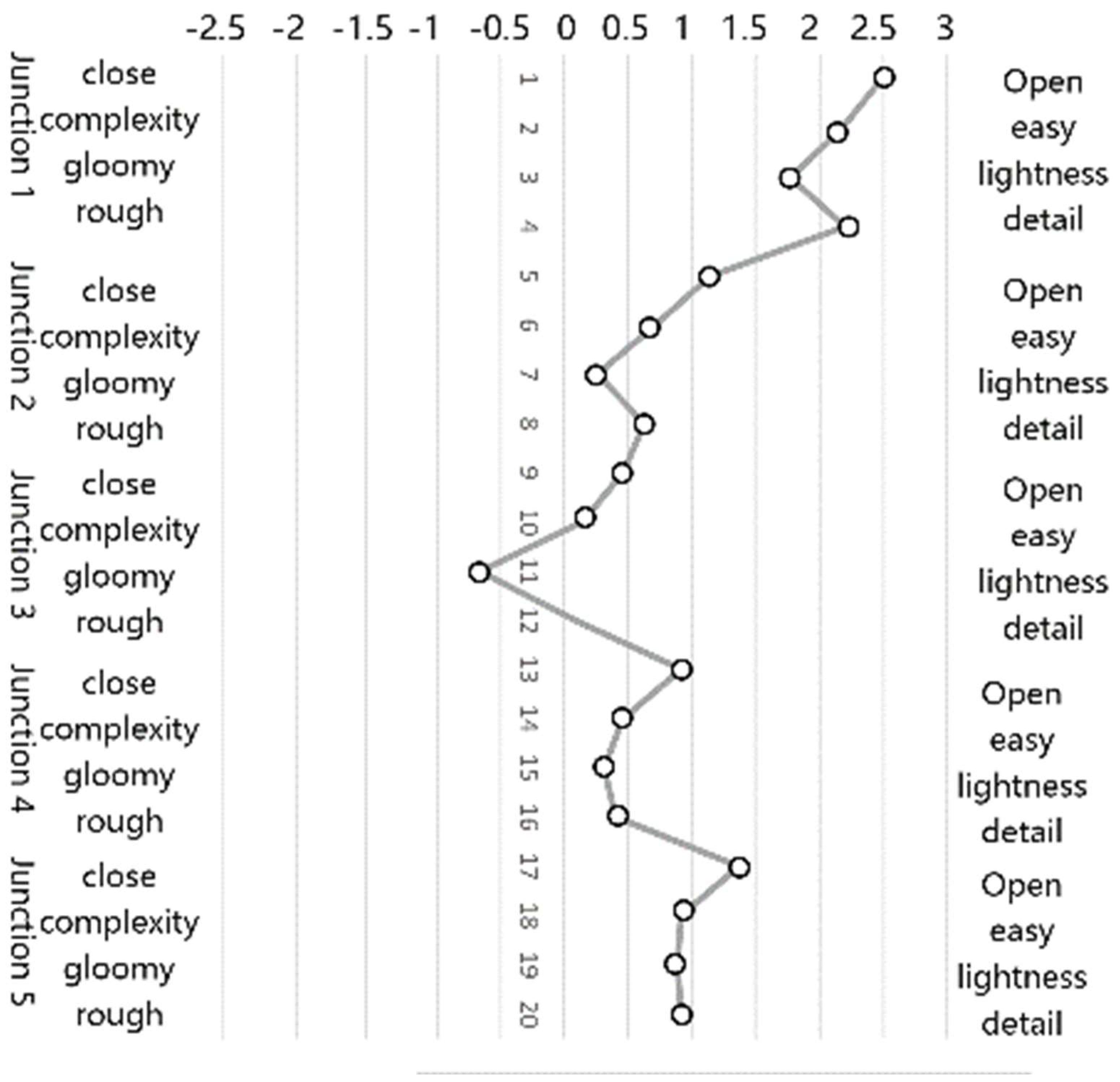Study on the Influence of Spatial Attributes on Passengers’ Path Selection at Fengtai High-Speed Railway Station Based on Eye Tracking
Abstract
:1. Introduction
2. Research Significance
3. Research Status
4. Research Purpose
- ①
- Impacts of different spatial attributes, such as the area of view of the transportation space of high-speed rail stations, on passengers’ path selection.
- ②
- Impact of different environmental elements of high-speed railway station transportation space on passenger route choice efficiency.
- ③
- Impact of different subjective evaluations on passengers’ attention to environmental elements.
- ④
- Factors affecting the correctness of wayfinding behaviour of passengers in the traffic space of high-speed rail stations and their respective strengths and weaknesses.
5. Research Methodology
Experimental Methodology
6. Conclusion of the Experiment
6.1. Conceptual Definition
6.2. The Effect of Spatial Attributes of Pathfinding Nodes on Subjects’ Pathfinding Behaviour and Efficiency
Effect of Spatial Attributes of Pathfinding Nodes on the Difficulty of Pathfinding for Subjects
6.3. Differences in Subjects’ Visual Attention Allocation under Different Spatial Attributes of Wayfinding Nodes
6.4. The Effect of the Number of Rides Taken by the Subjects on Eye Movement Attention
6.5. Order of Subjects’ Attention to Environmental Elements of Pathfinding Nodes
7. Analysis of Subjective Scoring Questionnaires
7.1. Questionnaire SD Assessment Results
7.2. Effect of Subjective Ratings of Pathfinding Nodes with Eye Movement Data from Different Partitions of the Corresponding Scene
7.3. Effect of Spatial Attributes of Wayfinding Nodes on Subjects’ Subjective Ratings
8. Prediction of Pathfinding Correctness
Regression Analysis of Pathfinding Behaviour Patterns
9. Summary
Author Contributions
Funding
Data Availability Statement
Conflicts of Interest
References
- Jin, L.; Yin, S.; Yin, J. Eye-movement characterization of wayfinding behavior in radial shopping space. Eng. Res. -Interdiscip. Perspect. Eng. 2019, 11, 121–128. [Google Scholar]
- Zhang, L.; Dang, H.; Mei, X.; Xie, Q. A preliminary study of urban ergonomics-oriented empirical research and design decision-making method for underground space interface. World Archit. 2021, 369, 19–23+126. [Google Scholar] [CrossRef]
- Zhang, L. Urban ergonomics: A new path of human-centered, high-quality space-oriented design intervention. Sci. Bull. 2022, 67, 1727–1728. [Google Scholar] [CrossRef]
- Li, J.; Zhao, R.; Wu, W.; Jin, Y. Human-environment interaction: Architectural spatial information and human perceptual feedback from the perspective of human factors architecture. Architect 2022, 217, 69–78. [Google Scholar] [CrossRef]
- Xu, J.; Zhu, X.; Wang, S. Experiments on path selection in subway stations based on on-site eye movement measurement and virtual scene—An example of three Guangzhou subway stations. New Archit. 2019, 4, 26–32. [Google Scholar]
- Sun, C.; Yang, Y. Research on the visual saliency of wayfinding signage based on eye tracking—An example of Harbin Cade Plaza Shopping Center. J. Archit. 2019, 2, 18–23. [Google Scholar]
- Ye, Y.; Qu, H.; Ma, Y.; Wang, K. A study on the influence of personal and environmental factors on wayfinding behavior based on eye movement analysis—Taking the campus of Shenyang University of Architecture as an example. Cent. China Archit. 2022, 40, 83–89. [Google Scholar] [CrossRef]
- Lu, W.; Bi, H.; Gu, Z. Research on display space measurement based on visual domain analysis—Taking Dalian urban planning exhibition center as an example. New Archit. 2022, 3, 15–20. [Google Scholar] [CrossRef]
- Wei, D.; Duan, X. A study on the performance of wayfinding in transportation space of elderly care facilities based on VR experiments. J. Archit. 2023, S2, 88–93. [Google Scholar]
- Qi, Y.; Zhang, Y.; Zhou, Q.; Zhang, L. Research on pathfinding and optimization of public space in outpatient department of large general hospital based on eye tracking. Contemp. Archit. 2021, 10, 118–122. [Google Scholar]
- Cao, M. Research on Wayfinding Design of Transportation Interchange Space in Beijing Railway Station. Master’s Thesis, Beijing Jiaotong University, Beijing, China, 2020. [Google Scholar] [CrossRef]
- Xu, L.; Zhang, W.; Tang, Z. A virtual study on the influence of signage layout features on wayfinding efficiency in subway stations. J. Archit. 2010, S1, 1–4. [Google Scholar]
- Xia, H.; Zhao, Y.; Xu, R.; Qu, L. Research on eye movement test and spatial optimization of wayfinding perception in subway station. South. Archit. 2022, 7, 1–9. [Google Scholar] [CrossRef]
- Li, J. Application of visual domain method in wayfinding design of large-scale comprehensive buildings. Art Educ. 2024, 5, 270–273. [Google Scholar]













| Experimental Item | Experimental Condition |
|---|---|
| Display content | Path selection program consisting of different nodes |
| Experimental equipment | On-screen eye-tracking device Electromyography Physiological Sensors (EDA) |
| Means of presentation | Screen display |
| Number of experimenters | 35 (20 women/15 men) |
| Independent Variable | Spatial Properties of Pathfinding Nodes/Spatial Properties of Markers |
| Implicit Variable | Path nodes spend time (tpn) Pathway choice correctness rate (cpn) Gaze duration (tg) and gaze order (Ng) for different environmental elements Pupil diameter of the subject while viewing the picture (Dp) Subjects’ familiarity with Fengtai Station (number of rides in six months Nht) |
| Abbreviation | Quantitative Data Meaning | |
|---|---|---|
| information density: | Di (%) | Percentage of all signs or cues with messages within the scene. |
| Density of key information | Dki (%) | Percentage of signs or cues within the scene that point to the final destination. |
| Connectivity | C | Connectivity measures the number of spaces immediately connecting a space of origin. |
| field of view | Fvc | Mean value of the area of the building visible from the observation point. |
| compactness | Cp | Compactness is to minimise metric or modular distance from all spaces to all others in any contiguous arrangement, and linearity is to minimise visual integration of the contiguous arrangement. |
| entropy (physics) | E | A measure of the distribution of locations of spaces in terms of their depth from a space. |
| degree of integration | Dig | Integration is a normalised measure of distance from any space of origin to all others in a system. In general, it calculates how close the origin space is to all other spaces, and can be seen as the measure of relative asymmetry (or relative depth). In general, it calculates how close the origin space is to all other spaces, and can be seen as the measure of relative asymmetry (or relative depth). |
| Average depth | Da | Mean depth is calculated by assigning a depth value to each space according to how many spaces it is away from the original space, summing these values and dividing by the number of spaces in the system less on (the original space). |
| Di (%) | Dki (%) | C | Fvc | Cp | E | Dig | Da | |
|---|---|---|---|---|---|---|---|---|
| Junction 1 | 0.018 | 0.007 | 857.000 | 857.027 | 0.066 | 1.011 | 16.891 | 1.480 |
| Junction 2 | 0.007 | 0.003 | 1205.000 | 1212.320 | 0.030 | 1.455 | 8.780 | 2.299 |
| Junction 3 | 0.043 | 0.011 | 3844.000 | 3854.080 | 0.011 | 1.203 | 13.233 | 1.864 |
| Junction 4 | 0.023 | 0.005 | 2598.000 | 2613.190 | 0.053 | 1.299 | 12.835 | 1.824 |
| Junction 5 | 0.017 | 0.003 | 2882.000 | 2896.710 | 0.043 | 1.293 | 13.293 | 1.802 |
| C | Fvc | Cp | E | Dig | Da | ||
|---|---|---|---|---|---|---|---|
| Tpn (s) | Pearson Correlation | 0.249 ** | 0.249 ** | −0.241 ** | 0.194 * | −0.199 ** | 0.190 * |
| Significance (two-tailed) | 0.001 | 0.001 | 0.001 | 0.010 | 0.008 | 0.012 | |
| Number of cases | 175 | 175 | 175 | 175 | 175 | 175 | |
| Di (%) | Dki (%) | ||
|---|---|---|---|
| Tpn (s) | Pearson Correlation | 0.202 ** | 0.095 |
| Significance (two-tailed) | 0.007 | 0.209 | |
| Number of cases | 175 | 175 |
| C | Fvc | Cp | E | Dig | Da | ||
|---|---|---|---|---|---|---|---|
| Dp (mm) | Pearson Correlation | 0.108 | 0.108 | −0.028 | 0.077 | −0.038 | 0.024 |
| Significance (two−tailed) | 0.156 | 0.154 | 0.718 | 0.316 | 0.615 | 0.750 | |
| Number of cases | 174 | 174 | 174 | 174 | 174 | 174 | |
| Tm (s) | Pearson Correlation | −0.528 ** | −0.530 ** | 0.317 ** | −0.397 ** | 0.299 ** | −0.255 ** |
| Significance (two−tailed) | 0.000 | 0.000 | 0.000 | 0.000 | 0.000 | 0.001 | |
| Number of cases | 174 | 174 | 174 | 174 | 174 | 174 | |
| Tp (s) | Pearson Correlation | 0.264 ** | 0.265 ** | 0.026 | 0.069 | 0.045 | −0.082 |
| Significance (two−tailed) | 0.000 | 0.000 | 0.730 | 0.363 | 0.557 | 0.281 | |
| Number of cases | 174 | 174 | 174 | 174 | 174 | 174 | |
| Tmb (s) | Pearson Correlation | −0.211 ** | −0.210 ** | 0.166 * | 0.101 | −0.073 | 0.060 |
| Significance (two−tailed) | 0.005 | 0.005 | 0.029 | 0.185 | 0.340 | 0.429 | |
| Number of cases | 174 | 174 | 174 | 174 | 174 | 174 | |
| Te (s) | Pearson Correlation | −0.037 | −0.037 | −0.186 * | 0.223 ** | −0.268 ** | 0.280 ** |
| Significance (two−tailed) | 0.629 | 0.630 | 0.014 | 0.003 | 0.000 | 0.000 | |
| Number of cases | 174 | 174 | 174 | 174 | 174 | 174 | |
| Di (%) | Dki (%) | Tpn (s) | |||
|---|---|---|---|---|---|
| Dp (mm) | Pearson Correlation | 0.013 | −0.069 | 0.002 | |
| Significance (two-tailed) | 0.869 | 0.364 | 0.975 | ||
| Number of cases | 174 | 174 | 174 | ||
| Total visit duration as a percentage (%) | Mechanism | Pearson Correlation | 0.213 ** | 0.106 | −0.245 ** |
| Significance (two-tailed) | 0.005 | 0.162 | 0.001 | ||
| Number of cases | 174 | 174 | 174 | ||
| Population | Pearson Correlation | 0.043 | −0.160 * | −0.015 | |
| Significance (two-tailed) | 0.574 | 0.035 | 0.841 | ||
| Number of cases | 174 | 174 | 174 | ||
| Message Board | Pearson Correlation | 0.294 ** | 0.277 ** | −0.264 ** | |
| Significance (two-tailed) | 0 | 0 | 0 | ||
| Number of cases | 174 | 174 | 174 | ||
| Environmental Element | Pearson Correlation | −0.071 | −0.042 | −0.114 | |
| Significance (two-tailed) | 0.354 | 0.578 | 0.134 | ||
| Number of cases | 174 | 174 | 174 | ||
| Dp (mm) | Message Board | Environmental Element | Mechanism | Population | ||
|---|---|---|---|---|---|---|
| Nht | Pearson Correlation | −0.022 | −0.137 * | −0.032 | −0.257 * | −0.131 |
| Significance (two-tailed) | 0.090 | 0.032 | 0.854 | 0.013 | 0.453 | |
| Number of cases | 35 | 35 | 35 | 35 | 35 | |
| Dp (mm) | Total Visit Duration as a Percentage | |||||
|---|---|---|---|---|---|---|
| Mechanism | Population | Message Board | Environmental Element | |||
| Closed-open | Pearson Correlation | 0.000 | 0.215 ** | -0.021 | 0.232 ** | 0.018 |
| Significance (two-tailed) | 0.996 | 0.004 | 0.784 | 0.002 | 0.812 | |
| Number of cases | 174 | 174 | 174 | 174 | 174 | |
| Rough-Details | Pearson Correlation | 0.020 | 0.207 ** | 0.031 | 0.160 * | 0.045 |
| Significance (two-tailed) | 0.798 | 0.006 | 0.689 | 0.035 | 0.555 | |
| Number of cases | 174 | 174 | 174 | 174 | 174 | |
| Dark-Bright | Pearson Correlation | 0.051 | 0.141 | −0.004 | 0.142 | 0.019 |
| Significance (two-tailed) | 0.500 | 0.064 | 0.956 | 0.061 | 0.803 | |
| Number of cases | 174 | 174 | 174 | 174 | 174 | |
| Complexity-simplicity | Pearson Correlation | 0.046 | 0.239 ** | 0.034 | 0.236 ** | −0.063 |
| Significance (two-tailed) | 0.548 | 0.002 | 0.652 | 0.002 | 0.409 | |
| Number of cases | 174 | 174 | 174 | 174 | 174 | |
| C | Fvc | Cp | E | Dig | Da | ||
|---|---|---|---|---|---|---|---|
| Sense of direction | Pearson Correlation | −0.368 ** | −0.368 ** | 0.385 ** | −0.279 ** | 0.280 ** | −0.274 ** |
| Significance (two-tailed) | 0.000 | 0.000 | 0.000 | 0.000 | 0.000 | 0.000 | |
| Number of cases | 175 | 175 | 175 | 175 | 175 | 175 | |
| Feeling of having lost one’s way | Pearson Correlation | −0.352 ** | −0.353 ** | 0.361 ** | −0.299 ** | 0.291 ** | −0.281 ** |
| Significance (two-tailed) | 0.000 | 0.000 | 0.000 | 0.000 | 0.000 | 0.000 | |
| Number of cases | 175 | 175 | 175 | 175 | 175 | 175 | |
| Marking validity | Pearson Correlation | −0.315 ** | −0.315 ** | 0.391 ** | −0.219 ** | 0.248 ** | −0.254 ** |
| Significance (two-tailed) | 0.000 | 0.000 | 0.000 | 0.004 | 0.001 | 0.001 | |
| Number of cases | 175 | 175 | 175 | 175 | 175 | 175 | |
| Pathfinding difficulty | Pearson Correlation | −0.338 ** | −0.338 ** | 0.357 ** | −0.302 ** | 0.296 ** | −0.287 ** |
| Significance (two-tailed) | 0.000 | 0.000 | 0.000 | 0.000 | 0.000 | 0.000 | |
| Number of cases | 175 | 175 | 175 | 175 | 175 | 175 |
| Hosmer–Lemeshaw Test | |||
|---|---|---|---|
| Move | Chi-Square (Math.) | (Number of) Degrees of Freedom (Physics) | Significance |
| 1 | 2.740 | 8 | 0.950 |
| Variables in the Equation | |||||||||
|---|---|---|---|---|---|---|---|---|---|
| B | Standard Error | Vardø (City in Finnmark, Norway) | (Number of) Degrees of Freedom (Physics) | Significance | Exp(B) | 95% Confidence Interval for Exp(B) | |||
| Lower Limit | Limit | ||||||||
| Step 1a | Di (%) | 373.0 | 136.05 | 7.52 | 1.0 | 0.006 | 0.604 | 0.377 | 0.966 |
| Dki (%) | −1033 | 428.44 | 5.82 | 1.0 | 0.016 | 0.420 | 0.163 | 1.084 | |
| Dp (mm) | −1.48 | 0.60 | 6.05 | 1.0 | 0.014 | 0.228 | 0.070 | 0.741 | |
| Tm (s) | −0.14 | 0.08 | 3.35 | 1.0 | 0.067 | 0.866 | 0.742 | 1.010 | |
| Pp (%) | −0.05 | 0.02 | 6.55 | 1.0 | 0.010 | 0.950 | 0.913 | 0.988 | |
| Pmb (%) | −0.13 | 0.03 | 18.31 | 1.0 | 0.000 | 0.879 | 0.828 | 0.932 | |
| Tp (s) | −0.02 | 0.01 | 1.85 | 1.0 | 0.173 | 0.985 | 0.963 | 1.007 | |
| constant | 5.13 | 2.58 | 3.95 | 1.0 | 0.047 | 168.76 | |||
| Step 1b | C | −0.50 | 0.24 | 4.42 | 1.0 | 0.356 | 0.604 | 0.377 | 0.966 |
| Fvc | 0.12 | 0.24 | 0.25 | 1.0 | 0.618 | 1.128 | 0.702 | 1.814 | |
| Cp | 0.14 | 0.14 | 0.98 | 1.0 | 0.322 | 1.147 | 0.874 | 1.506 | |
| constant | −0.55 | 0.23 | 5.90 | 1.0 | 0.015 | 0.575 | |||
Disclaimer/Publisher’s Note: The statements, opinions and data contained in all publications are solely those of the individual author(s) and contributor(s) and not of MDPI and/or the editor(s). MDPI and/or the editor(s) disclaim responsibility for any injury to people or property resulting from any ideas, methods, instructions or products referred to in the content. |
© 2024 by the authors. Licensee MDPI, Basel, Switzerland. This article is an open access article distributed under the terms and conditions of the Creative Commons Attribution (CC BY) license (https://creativecommons.org/licenses/by/4.0/).
Share and Cite
Zeng, Z.; Zhang, K.; Zhang, B. Study on the Influence of Spatial Attributes on Passengers’ Path Selection at Fengtai High-Speed Railway Station Based on Eye Tracking. Buildings 2024, 14, 3012. https://doi.org/10.3390/buildings14093012
Zeng Z, Zhang K, Zhang B. Study on the Influence of Spatial Attributes on Passengers’ Path Selection at Fengtai High-Speed Railway Station Based on Eye Tracking. Buildings. 2024; 14(9):3012. https://doi.org/10.3390/buildings14093012
Chicago/Turabian StyleZeng, Zhongzhong, Kun Zhang, and Bo Zhang. 2024. "Study on the Influence of Spatial Attributes on Passengers’ Path Selection at Fengtai High-Speed Railway Station Based on Eye Tracking" Buildings 14, no. 9: 3012. https://doi.org/10.3390/buildings14093012






